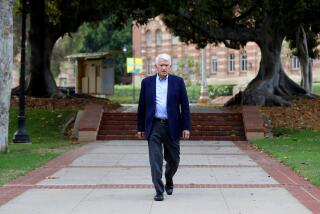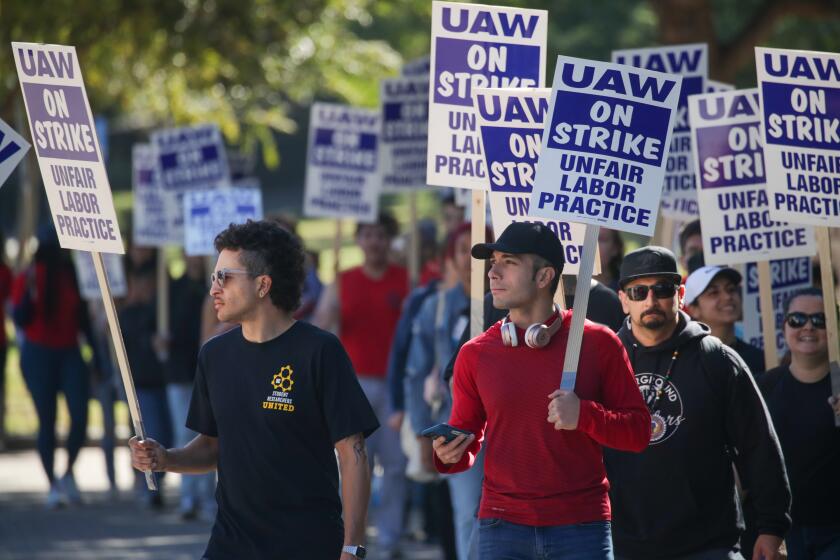Growing Welfare Rolls Reflect a Divided Area : Demography: Assistance to Valley residents doubles in 30 months, skyrocketing among poor Latino families.
One of California’s least known but most ambitious educational reforms is taking shape at half a dozen city schools in the poorest corner of the San Fernando Valley.
The program has little to do with the three Rs, though it’s founded on simple arithmetic.
Officials at the six schools say most of their 7,400 students are eligible for state Medi-Cal benefits, but few receive them. Under the novel program, a neighborhood health-care system is being created that will eventually offer services ranging from routine exams and family counseling to surgery.
The landmark proposal reveals the magnitude of the Valley’s population shift. The transformation has been marked by a decline in the ranks of the middle class, once firmly entrenched in nearly every neighborhood from North Hollywood to Canoga Park.
The schools--located in predominantly Latino neighborhoods of the northeast Valley--found in a privately funded survey that:
* More than 75% of the students’ families have no health insurance, either private or the government-funded Medi-Cal program.
* Ninety-six percent of the students are eligible for the federally subsidized free lunch program and therefore are likely to be eligible for county-administered welfare programs, such as Medi-Cal, food stamps and Aid to Families With Dependent Children.
* Nearly 80% of the students are U.S.-born, dispelling notions that Valley public schools with large Spanish-speaking enrollments are serving mostly immigrant children.
The skyrocketing number of welfare recipients in the Valley, which doubled in 30 months, is growing faster than the rate in Los Angeles as a whole. The survey suggests that those numbers are likely to accelerate even more dramatically, fueled by the lingering recession and a new, eligible generation.
The school survey also supports U. S. census information showing that the Valley--once considered the quintessential middle-class suburb--has become increasingly divided between rich and poor.
And it supports growing evidence that the San Fernando Valley of the future will be predominantly composed of minorities and--if there is no improvement in education or employment--a much tougher place to raise a family than in years past.
“I would say that the number of families eligible for welfare is 30% to 35% understated,” said Kenneth E. Bohaty, a California Department of Health worker on loan as a consultant to the school project. “There are social and cultural barriers keeping people away from services they are eligible for. One is a fear of detection. But even if the parents are not U. S. citizens, it is possible for the child to be eligible if they are born here.”
The troubled economy combined with growing numbers of poor, undereducated immigrants has created the potential for a new welfare-dependent group made up largely of Latino families, both unemployed and working poor, county welfare officials say.
*
The decline in high-wage jobs prompted by business flight and plant closures in the Valley have forced many onto welfare rolls who had previously resisted government help, especially among Latinos and Asians, county welfare workers said.
And, according to the school survey, many of those going without government help are getting by without the financial base that allows for insurance or even routine medical visits.
It is still unclear whether the trend will reverse when the economy recovers.
Hector Delgado, a professor of sociology and Mexican American studies at the University of Arizona at Tucson, believes the number of Latino welfare recipients will decline as the economy improves.
But Robert Valdez, a UCLA health science professor and researcher at the RAND Corp. think tank, is less optimistic. “We don’t know if the increase is a transitory or permanent increase,” he said. “But even if you do build up some dependence, you don’t expect it to be 100%. . . . Being on welfare rolls for many is degrading, admitting that you cannot provide for the family.”
Whatever the outcome, Delgado said welfare growth among Latinos “will increase feelings against immigrants. . . . In the past, the focus was on taking jobs. Now, it is about the drain on public coffers through social services.”
So far, the growth in demand for public services by all races and nationalities in the Valley has been a largely hidden trend. County records and U. S. census information show:
* The number of welfare recipients in some Valley communities has grown as much as 40% over 18 months, a rate twice that of neighborhoods in South Los Angeles.
* About one-fifth of the populations of North Hollywood, Arleta, Pacoima, Van Nuys, Mission Hills, Panorama City, North Hills and Sun Valley were receiving some form of public assistance this summer, double the proportion of 16 months earlier.
* Between January, 1991, and July, 1993, the total number of welfare recipients in the Valley more than doubled, increasing from about 80,000 to nearly 175,000.
* Countywide, the number of Spanish-speaking welfare recipients has more than doubled between April, 1990, and April, 1993. English-speaking recipients grew by one-third during that same period.
Government assistance to Valley residents reflects the area’s changing population, growing fastest among Latinos and to a lesser degree among Chinese, Vietnamese and Armenian immigrants, as well as those from Eastern Europe and the Middle East, said Ike August, district director for the county Department of Public Social Services in the West Valley.
“We’re helping different groups of people who never used to be seen in the Valley,” said August, who has worked in Valley welfare offices for 10 years.
The proportion of African Americans on welfare in the Valley has remained static, with other ethnic groups growing but dwarfed by increases among Latinos, he said.
*
The school survey supports contentions that the number of families receiving welfare assistance, especially among immigrants, is small compared with the number who are eligible for benefits.
But welfare officials predict the gap will close unless the economy rebounds, as more families seek government help.
“We average 70,000 applications for aid a month,” said Paul Fast, statistical analyst for the Los Angeles County Department of Public Social Services, which administers welfare programs. “And there are still vast areas of unmet need. That frightens me.”
County welfare officials and eligibility workers in the Valley report that tough times have brought in new clients who include longtime residents who have lost their jobs in the recession.
“We are seeing people who held good positions, who don’t want to be on welfare and who resent the thick application forms and some of the rules,” August said. “I think they’ll get off welfare when things improve. But the rest? It depends on their motivation. Complacency is just a killer.”
Outside the West Valley welfare office in Canoga Park, Ana Maria Gonzalez, an immigrant, explained why she was applying for Medi-Cal for her two U. S.-born children.
“I can’t afford to take them to the doctor,” said Gonzalez, 29, who came to the Valley from Guatemala nine years ago.
Medi-Cal benefits to the children of immigrants are among the state’s fastest-growing expenses.
It is also the fastest-growing expense for the Valley, along with aid to unemployed families with children, county records show.
Welfare officials and eligibility workers predict that a growing proportion of aid recipients will probably remain dependent on government assistance because of limited skills, a lack of education and problems speaking English.
“This is a scary generation coming in, the teen-age parents,” said August. “I don’t see much hope for them.”
*
Yvonne Chan, principal of the former Vaughn Street Elementary School--now called the Vaughn Next Century Learning Center--said that is why she has been working for the past nine months on the proposal to create the school-based health cooperative.
“If we continue to talk only about education and not the social and health needs of the child, we’re never going to win,” said Chan, whose San Fernando school won administrative and limited financial independence this year from the Los Angeles Unified School District through a new state law creating charter schools. “Compare the costs of nurses with the costs of jail,” she said.
Using its charter school status, Vaughn Street has become the first public school in California to be eligible for Medi-Cal reimbursement. The plan is to begin charging the state for health exams and routine medical care at the school and within two years expand the program to include a host of medical procedures and referrals to local Medi-Cal doctors and clinics.
Adapting an educational system to the needs of a growing immigrant population and its U. S.-born children poses a continuing challenge for the Los Angeles school district. Among immigrant Latinos in the Valley, half have less than a ninth-grade education, according to a Times analysis of the 1990 census. And with wages several times higher in the United States than in Mexico, there is little incentive for many of these workers to continue their schooling, especially when the work available to them does not require it.
About half earn less than $10,000 a year. Few have reached even moderate financial success, as only 15% of Latino immigrants report earnings greater than $20,000 a year. Furthermore, these numbers from the 1990 census were reported before the full brunt of the recession hit.
The U. S.-born Latino in the Valley is far better off than the Latino immigrant, earning more money and twice as likely to own a home. About 40% of Valley Latinos who are U. S. citizens report annual incomes greater than $20,000.
Compounding the problem of advancement are language barriers for Latino immigrants and their U. S.-born children. Half the adult Latinos in the census reported that they do not speak English well or at all.
While the lives of immigrants may have improved dramatically compared to life in their home countries, their prospects and those of their children are stunted by a lack of education, experts said.
“Many of the profound changes bringing misery and despair to the people of Los Angeles County may be attributed to the spectacular growth of an uneducated and intellectually incompetent citizenry that cannot succeed, except in the most minimal fashion, in an increasingly complex and technologically advanced world,” wrote William Bowen, Cal State Northridge geography department chairman, in a study of the U.S. Census he and colleagues have undertaken.
*
Throughout the 1950s and 1960s, public school students in the San Fernando Valley were overwhelmingly white.
By 1975, white enrollment fell to 75%. In 1982, white students made up 50% of public school enrollment in the Valley, with Latinos making up 40%. Ten years later, Latinos made up 60% of the total, while Anglos are 27%, school district records show.
Looking at school enrollment by neighborhood shows dramatic changes over the past 10 years.
White enrollment has fallen by at least half between 1982 and 1992 in eight of the Valley’s 17 high school enrollment areas, reflecting a decline in the number of white, middle-class families living in the Valley.
Put another way, white students remain a majority only in neighborhoods surrounding Taft, Granada Hills and El Camino Real high schools. While magnet schools, some of which are considered among the nation’s finest, were created in part to retain middle-class families, they have failed to stem the decline in white enrollment.
To many, the prospect that one-third to one-half of Valley students will not earn a high school diploma is alarming. The overall dropout rate at Los Angeles high schools is more than 35%, with Latinos dropping out at even greater rates.
Experts say the Valley’s future depends not only upon preparing minority students for productive lives but on persuading middle- and upper-middle-class families to stay, perhaps with the promise of improvements such as modern rapid transit.
The quality of work in the Valley steadily improved in the first decades after World War II, giving families the chance to move up the economic ladder. That changed with the waning of the Cold War and then the recession.
The first high-tech industrial center of the Valley grew rapidly after the war, concentrated around the Lockheed Corp. plant in Burbank, which is now closed. By the early 1960s, the focus had shifted to Chatsworth and Canoga Park, with many small- and medium-size firms working as subcontractors for Rockwell’s large Rocketdyne facility.
With defense budgets reduced--probably for the foreseeable future--UCLA geography professor Allen J. Scott maintains that these Valley firms must look beyond the defense industry for their markets. Otherwise, Scott said, an economic rebound may benefit newer, more flexible high-technology firms in Ventura County, which are less dependent on government-sponsored goods such as aerospace.
The Valley has the best chance to prosper and employ its new arrivals if it can become a center for high-tech civilian products such as electric cars and mass transit systems, said Scott, who directs the Lewis Center for Regional Policy Studies at UCLA.
“It’s anybody’s guess whether that will happen,” he said.
In the meantime, the demographic and cultural changes in the Valley progress, with economic and ethnic divisions deepening.
But that’s not necessarily a bad thing, according to USC urban planning professor James Moore. Face it, he said, the Valley, like Los Angeles as a whole, is unlikely to ever return to the way it was in the 1950s and 1960s.
“My contention is that the folks who choose to migrate are a special category,” said Moore. “They are less risk-averse, willing to defer gratification, willing to demonstrate a little courage. That’s not something I want to miss out on. If they are going to land someplace, I want them here.”
Moore said anti-immigrant sentiment ignores market forces that can benefit both groups. Immigrants contribute labor in exchange for an opportunity to advance economically.
“You have to tolerate and acknowledge other cultures, and if you want to make money, you have to be willing to trade with them,” Moore said. “We can try to punish immigrants but that will cost us the human capital we need . . . so an anti-immigrant stance is like declaring war instead of trade.”
Then what are Valley residents to expect?
“Maybe we should look at Jerusalem,” Moore said. “The administration of Jerusalem has not attempted to integrate the cultures, but it has existed as a relatively peaceful place because the various ethnic factions recognize each other’s contributions. Not a melting pot, but a mosaic.”
Times Director of Computer Analysis Richard O’Reilly assisted with this article.
Valley Immigrants: A Latino Portrait Half the Valley’s adult Latinos are not U.S. citizens, but their children are-making them eligible for government services. The area’s decline in high-wage jobs has spurred the growth of a new welfare-dependent group made up increasingly of Latino families. Welfare Rolls Swell Countywide, the number of Spanish-speaking welfare recipients more than doubled between April, 1990, and April, 1993. English-speaking recipients grew by one-third during the same period. April, 1990 Spanish: 66,004 English: 251,639 April, 1993 Spanish: 138,688 English: 336,078 Most Students Are U.S. Born Despite a dramatic increase in the number of Spanish speakers in city schools, 155,190of the Valley’s 174,016 students are U.S.-born. U.S. citizens: 90% Foreign-born-non-citizens: 10% Immigrants Trail U.S.-Born Latinos About half of non-citizen Latinos in the Valley earn less than $10,000 a year. Only 15% report earnings greater than $20,000 annually. But 40% of U.S.-born Latino adults report annual incomes greater than $20,000, and they are twice as likely to own a home. Language remains a key barrier to non-citizens.
Income U.S.-born Non-citizen $0-$9,999 32% 49% $10,000-$19,999 27% 36% $20,000-$39,000 31% 13% $40,000-$59,000 8% 2%
Housing U.S.-born Non-citizen Own home 42% 21% Rent 49% 76%
Ability to Speak English U.S.-born Non-citizen Not well 4% 31% Not at all 1% 19%
Sources: U.S. Census Bureau; L.A. County Dept. of Public Social Services; Los Angeles Unified School District
The Change on Campus The growing number of Latinos in the San Fernando Valley has brought changes to institutions such as public schools. Valley School Ethnicity Latinos have become the majority of students enrolled in Valley schools. 1982, (125,487 students) White: 50% Latino: 37% Black: 6% Asian: 5% Other: 2% 1992, (156,386 students) White: 27% Latino: 60% Black: 6% Asian: 6% Other: 1% Future of Valley Schools Elementary-age students are the fastest growing group at Valley schools. Increasing numbers of Latino students in the lower grades foreshadow a rising proportion of Latino enrollment overall. Third Grade 1982 White: 39% Latino: 48% Black: 6% Asian: 5% Other: 2% 1992 White: 26% Latino: 61% Black: 6% Asian: 5% Other: 2% Source: Los Angeles Unified School District
More to Read
Start your day right
Sign up for Essential California for news, features and recommendations from the L.A. Times and beyond in your inbox six days a week.
You may occasionally receive promotional content from the Los Angeles Times.






